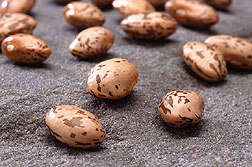A Prize Pinto, a Better Bean
When it comes to survival, Burke is a real scrapper.
The latest pinto bean cultivar from Agricultural Research Service and Washington State University (WSU) scientists, Burke fends off several harmful viruses and fungi that can fell a lesser plant.
Scientists bred the cultivar with a potent genetic package conferring high levels of disease resistance. This should give commercial growers added insurance against culprits like the bean common mosaic virus and bean common necrosis virus. Both can cause yield losses of up to 60 percent.
A third menace, the curly top virus, is "a regional problem--mainly in the Pacific Northwest, where seed stock is produced," says Phillip N. Miklas, a geneticist in ARS' Vegetable and Forage Crops Production Research Unit at Prosser, Washington.
He is part of a bean-breeding team that includes ARS plant pathologists Matt J. Silbernagel and J. Rennie Stavely and WSU colleague An N. Hang. Their prized pinto debuts this summer for production in western states including Colorado, Idaho, Washington, and Wyoming.
Besides viruses, the new cultivar also resists U.S. forms of the rust fungus, Uromyces appendiculatus. Unchecked by chemical fungicide or other measures, Uromyces causes a rust-colored blight on the leaves of susceptible bean plants. Severe outbreaks may wipe out an entire crop. But with Burke, the fungus never gains a firm toehold in the rest of the plant, so it doesn't cause serious disease.
The cultivar also withstands Pythium and Fusarium fungi, soil-dwelling microbes that can inflict costly root rots.
"When conditions are ripe for root rot, you can have 20 to 30 percent yield losses," notes Miklas. "Burke has a thriving network of roots that allows it to survive damage caused by the fungi."
Farmers planting the hardy cultivar will get semi-upright plants that mature in 89 to 95 days. Burke produces large, firm, tan-colored seeds that cook and store nicely without turning into a crumbly, unappealing mush. That's important, considering how fond American consumers are of pinto beans--eating more than 3 pounds per person each year, according to USDA's Economic Research Service.
While firm, high-quality seed is important to a cultivar's success, so is high yield. Burke seems to measure up on both counts. In test plantings at 40 different locations in the Midwest and Northwest from 1994 to 1996, Burke outperformed 8 competing pinto lines in the National Dry Bean Cooperative Nursery.
In Colorado test plots, Burke's yields were up to 12 percent higher than the industry standards, Othello and Sierra.
One likely reason: Burke is a cross between these two venerable cultivars, so it possesses many of the desirable features of both, says Silbernagel. Now retired, he and Hang did the original breeding work that led to Burke.
"Othello is one of the most widely grown pinto beans because it performs well under many different growing conditions," says Miklas, who is Silbernagel's successor. "An advantage of Burke over Othello is better disease resistance."
The new pinto line also earned higher ratings for canning quality in tests conducted by ARS' George Hosfield at Michigan State University. Encouraged by test results, Miklas' group applied for plant variety protection on Burke. This will help ensure the cultivar's genetic purity and longevity as it goes into commercial production.--By Jan Suszkiw, Agricultural Research Service Information Staff.
Phillip N. Miklas and Matt J. Silbernagel (retired) can be reached at the USDA-ARS Vegetable and Forage Crops Production Research Unit, 24106 North Bunn Rd., Prosser, WA 99350; phone (509) 786-9258, fax (509) 786-9277.
"A Prize Pinto, a Better Bean" was published in the July 1998 issue of Agricultural Research magazine. Click here to see this issue's table of contents.







